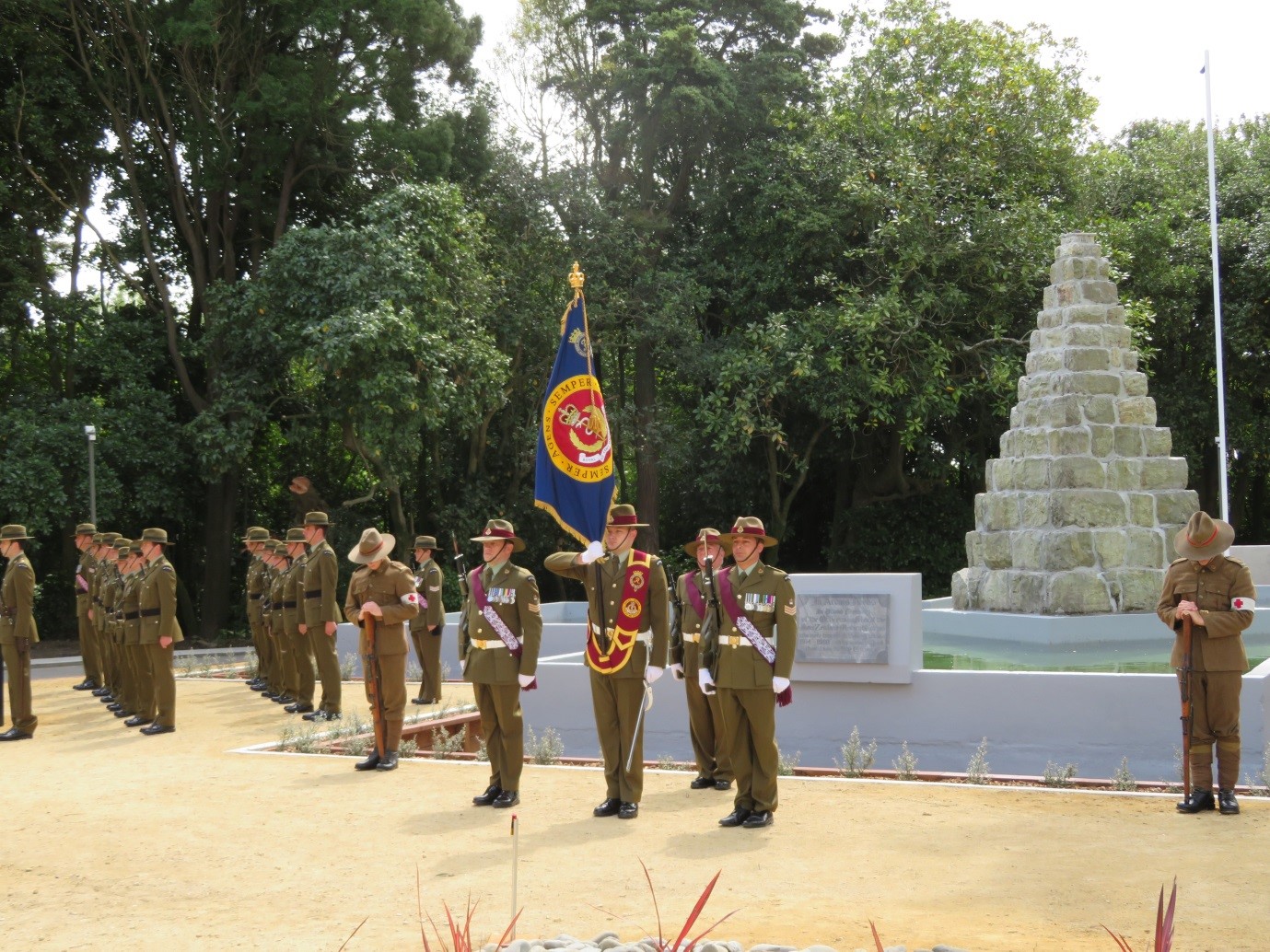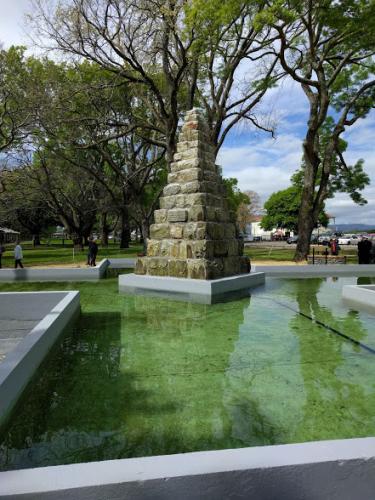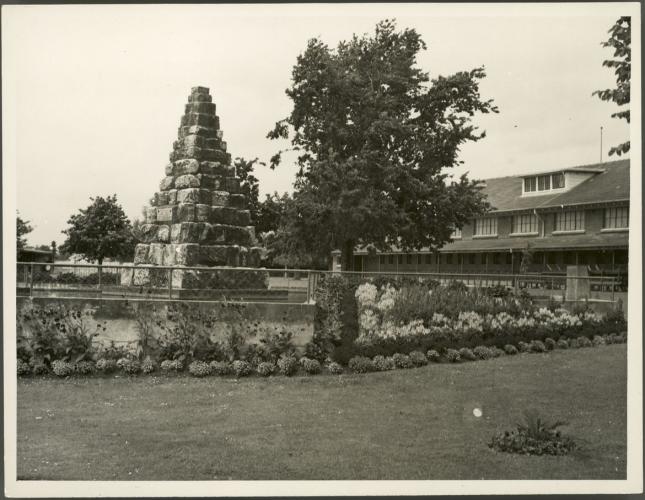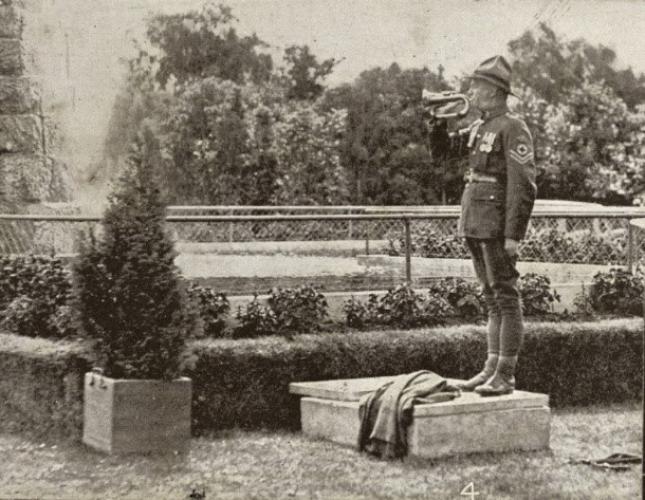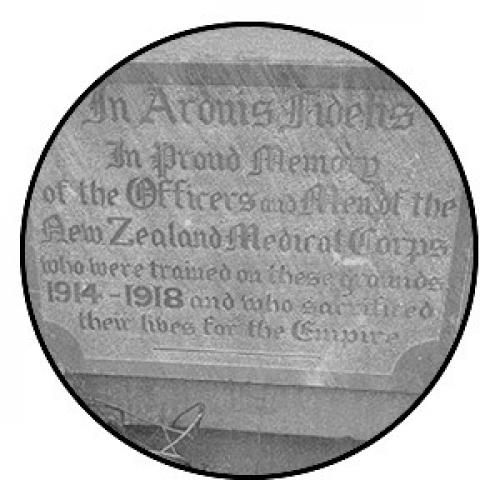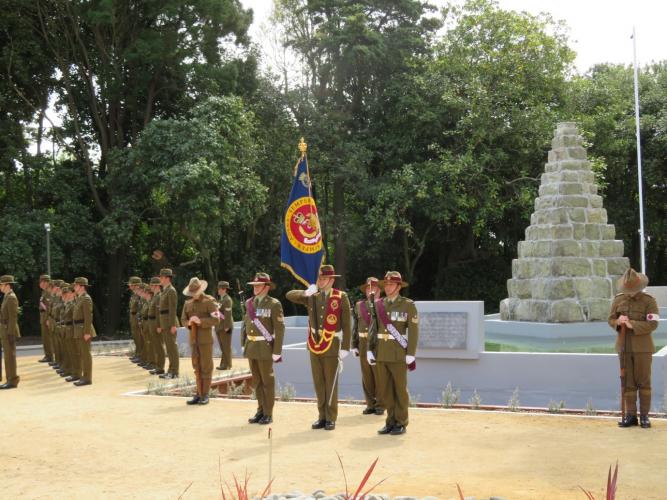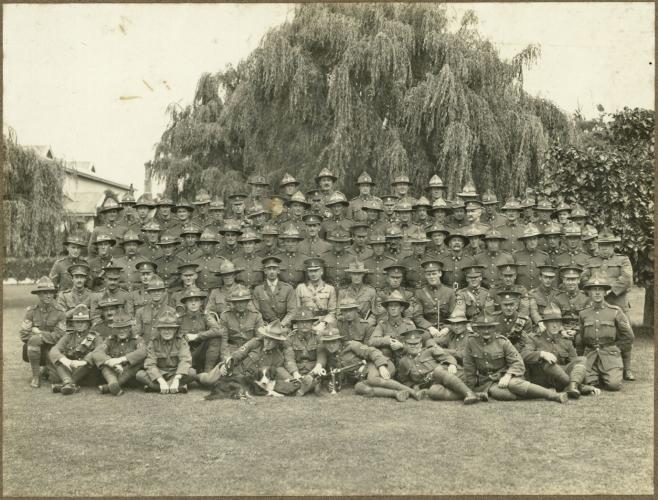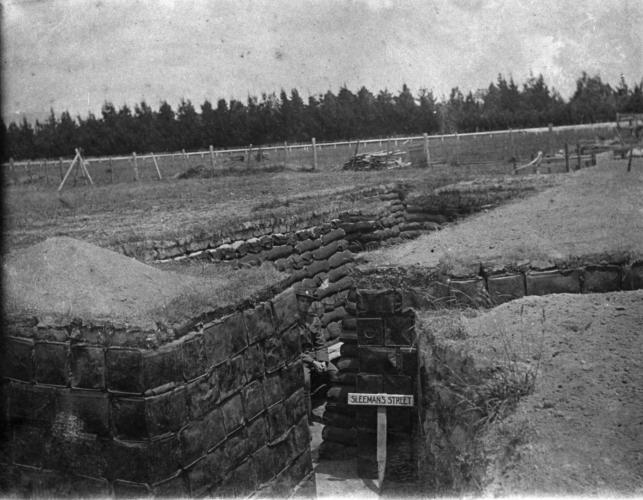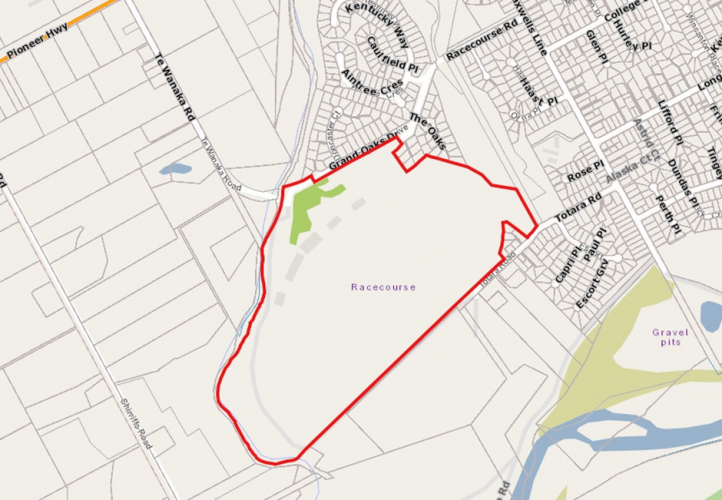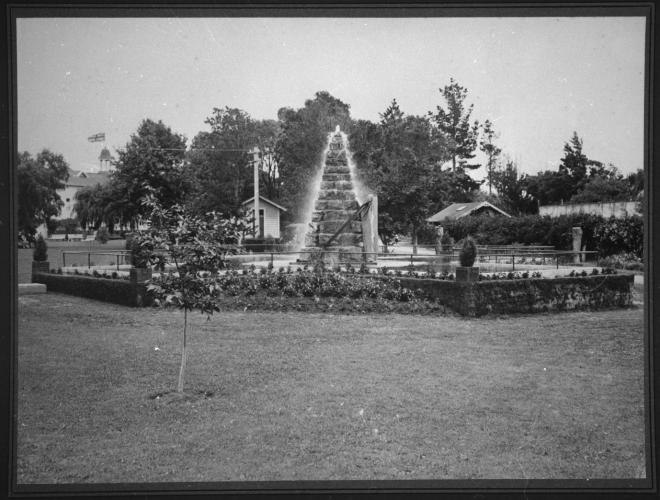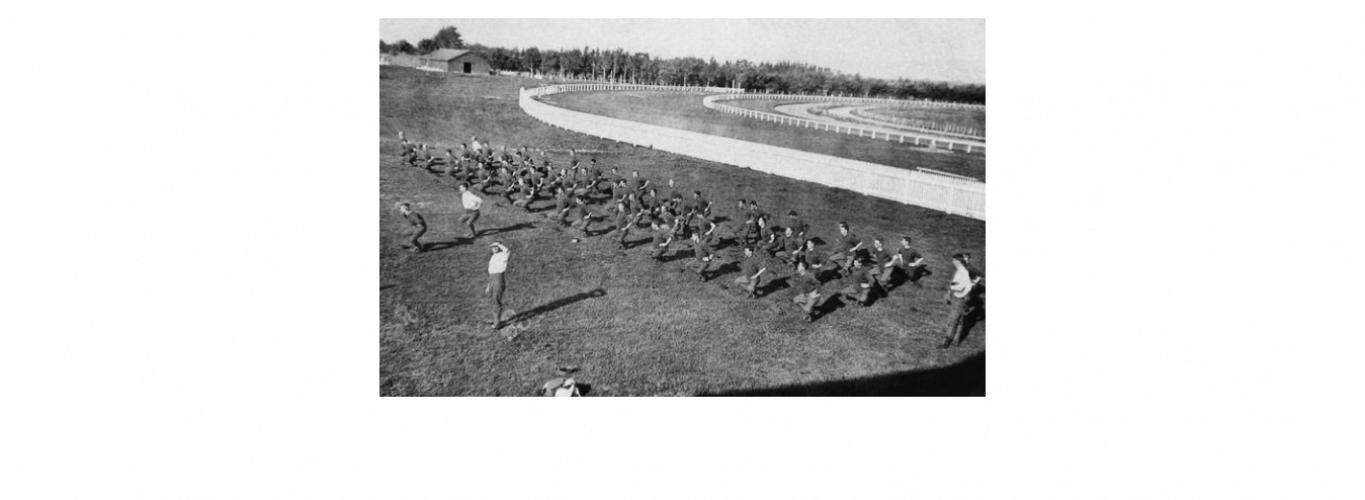120 Awapuni Memorial Palmerston North, RNZAMC Cenotaph, Photo Terry McBeth
Reason for the name
The Awapuni Medical Corps Memorial was established on the grounds of the Awapuni Racecourse in December 1929, with the dedication stone stating, “In proud memory of the officers and men of the New Zealand Medical Corps who were trained on these grounds from 1914-1918 and who sacrificed their lives for the Empire”. Noted as the only known monument in New Zealand solely dedicated to commemorating the service of the New Zealand Medical Corps, the memorial was re-dedicated in 2016 after an extensive restoration project by the New Zealand Army returned it to its original state.
Awapuni Racecourse was home to one of New Zealand’s largest training camps in WW1, and was the sole location for training the New Zealand Medical Corps staff. The Memorial marks this site as a place of special significance. The Racecourse was also used as a military training ground during World War II.
The Awapuni Medical Corps Memorial is located near the northern boundary of the Awapuni Racecourse amongst a grove of karaka trees, situated on lot 2 of DP 437961 of the Wellington Land District. The entrance to the grounds is via the main gates along Racecourse Road. Other amenities in the area include Otira, Mangaone, Rangitane parks to the north and northeast, and Totaranui and Paneiri parks to the east. The Mangaone Stream Walkway leading to the Manawatu River also meanders through the area.
Author: Evan Greensides, Heritage Assistant for Palmerston North City Libraries & Community Services.
History of the Awapuni Racecourse Area
In 1867 Dr Isaac Featherston bought Sections 364-366, the land now occupied by the Awapuni Racecourse, then on selling the property to solicitor and harness racer Mr A S Baker. While the Manawatu Racing Club conducted its first race meeting in Palmerston North on Boxing Day 1881, it wasn’t until 1900 that the Trustees of the Manawatu Racing Club purchased the full 100 acres of land at Awapuni for £4000, with the Club celebrating its first race-day at the new course on Boxing Day, 1903.
As part of the national commitment to form an 8,500 man New Zealand Expeditionary Force upon the outbreak of war in 1914, the Awapuni Racecourse was seen as a good site for training new recruits by the Wellington District. Palmerston North was centrally located and at the hub of the North Island railway network, the district headquarters were cited there, and the Awapuni site was wide open, flat country on the outskirts of the growing town. The authorities soon leased the site from the Manawatu Racing Club, free of charge, on the proviso that the facilities were returned to their pre-war state after the camp closed. The camp opened on 13 August 1914 and men from all over the lower North Island soon began to filter in to begin training.
The main oval inside the course was filled with tents arranged by district, with the infantry, mounted rifles and engineers taking up this space and the artillery in an adjacent paddock. Training courses were set up, with infantry using the 12 kilometre round trip to the rifle range in Hokowhitu as a daily route march and the mounted riflemen and artillery utilising the fields around the town for their own training. After the government made the decision to use Trentham Camp as the central training area for future troop reinforcements, Awapuni was wound down and returned to the Manawatu Racing Club. After the last troops boarded trains for Wellington on 22 September, 4,198 men of all ranks passed through the Awapuni Camp during its initial six weeks of operation in 1914.
This initial early-war training period was only the beginning for Awapuni. After receiving feedback from officers serving at the Gallipoli front stating that medics had not been fully prepared for battle conditions and modern warfare, the British Army Council dispatched Colonel Robert Henderson to take over medical training in New Zealand. As a result, the Awapuni Racecourse area was re-acquired in September 1915, from then on being dedicated solely to the training of medical personnel. The grounds, buildings and facilities were converted to meet the needs of the 400 personnel who soon entered the camp. The local economy also received a boost as the quartermaster for the camp sourced the majority of provisions from local suppliers.
The Awapuni training camp was unique in that both officers and men utilised the grandstands area as sleeping quarters for its perceived health benefits of avoiding the mud and squalor which had overwhelmed Trentham a year earlier, saving money on tents, as well as preserving the race course paddocks. The recruits that arrived in this environment passed through a 16 week basic training – nine weeks of basic training at Awapuni, followed by four weeks hands-on hospital training at Featherston or Trentham, capped by a final week of training back in Awapuni. Rigorous exercise and drill training programmes were enacted, and the recruits were thoroughly educated via lectures on hygiene, sanitation, disease and maintaining health.
The Awapuni training programme focussed on treating sick and wounded personnel in conditions which they would encounter once overseas and through the entire care process, from front line to distant hospitals. A 550m long model trench system was installed, complete with angular walkways, listening posts, dugouts and underground first aid treatment centres. Two horse ambulances and a motorised section were utilised, allowing the men to practice evacuations from the front line. A railway carriage was also made available for hospital train work. Two large scale training exercises, one in September 1916 in Tiritea, the other in June 1917 in Wanganui, were also conducted, requiring recruits to undertake first aid and evacuation procedures in battlefield conditions.
Once the Armistice was signed on 11 November 1918 the camp’s functions began to wind down, though it was kept temporarily open by Colonel Henderson in order to train men for the hospital ship Marama, as well as man military hospitals treating returned wounded soldiers. The decision to close the camp was made in mid-January 1919, and the camp was officially returned to the Manawatu Racing Club on 14 February. Although the elaborate trench system was labelled, “the most complete in the Dominion”, it was soon filled in and the area was returned to its pre-war state.
With the dedication of the Cenotaph in The Square to all of the Manawatu district’s war dead in February 1926, the Manawatu Racing Club’s president, Mr C Louisson, decided that the Army Medical Corps long presence at the Racecourse and sacrifices overseas warranted a memorial dedicated to the unit. The Club secretary, Mr John Moore Johnston, designed the memorial with symbolism and emotional impact at the forefront of his mind – the cairn-like fountain; a surrounding pool shaped to the Red Cross symbol; and ‘tears’ emanating from the top of the fountain. Red and white flower beds also originally surrounded the pool, enhancing these effects.
Unveiled on the afternoon of 3 December 1929, the memorial was well attended by the public and ex-members of the Army Medical Corps. Speakers at the ceremony included Major-General Young, COG of New Zealand Forces, Colonel Tracey Inglis, Director of Medical Services, Colonel Parkes, as well as Governor-General Sir Charles Fergusson and wife Lady Alice Fergusson. The Governor-General spoke, stating,
Only by love, and sympathy and sacrifice for our fellow-men can we repay the debt we owe these men whose memory we are commemorating. We must make of duty something more than a word. We must see that their deeds are not forgotten, and that each of us does what is in his power to teach those coming after him that only by self-sacrifice can a nation become great, prosperous and blessed.
Although the memorial was a place of gatherings of remembrance after its unveiling in 1929, the expansion of the racecourse area led to it being hidden from general view. A push in 2014 by the public and New Zealand Army to rehabilitate the memorial and surrounding structure, which had not been touched in 85 years, led to full restoration work being undertaken. This included conservation of the cairn and pool, removal of pump shed and trenching the reservoir plumbing, as well as the installation of seating, lighting, signage, flag station and a curved wall at the north end of the pool. The memorial was officially rededicated on 20 October 2016, with the Joint Operational Health Group carrying the RNZAMC Banner and acting as guards.


